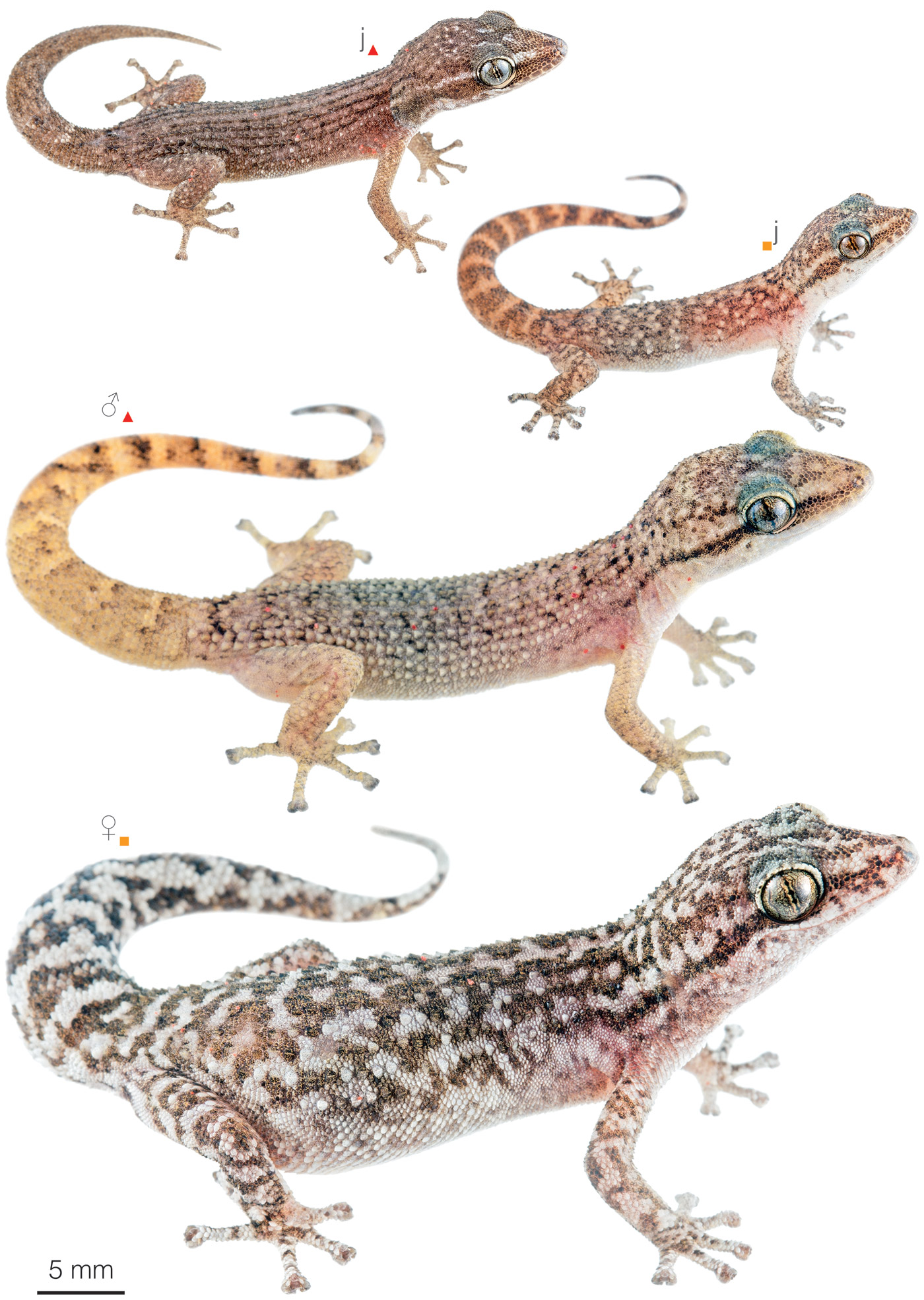Published May 30, 2019. Updated December 27, 2023. Open access. | Purchase book ❯ |
River Leaf-toed Gecko (Phyllodactylus leoni)
Reptiles of Ecuador | Sauria | Phyllodactylidae | Phyllodactylus leoni
English common names: River Leaf-toed Gecko, Río León Leaf-toed Gecko.
Spanish common names: Geco de río, salamanquesa del Río León.
Recognition: ♂♂ 11.4 cmMaximum distance from the snout to the tip of the tail. Snout–vent length=5.5 cm. ♀♀ 10.9 cmMaximum distance from the snout to the tip of the tail. Snout–vent length=5.1 cm..1 Phyllodactylus leoni is easily distinguishable from other geckos occurring in the dry forests of the Río Jubones watershed by having narrow and rounded digital disks and dorsal surfaces covered by rows of densely packed tubercles that are strongly keeled, large, and trihedral (Fig. 1).1 The dorsal coloration is usually pale grayish brown with dark gray reticulations and a thin black postocular stripe that extends to the insertion of the forearms (Fig. 1).1,2 Phyllodactylus leoni differs from P. reissii by being smaller and by having granular scales on the throat (flat and juxtaposed in P. reissii).1,3

Figure 1: Individuals of Phyllodactylus leoni from Azuay province, Ecuador: Santa Isabel (); Río León (). j=juvenile.
Natural history: Phyllodactylus leoni is a nocturnal and terrestrial gecko that inhabits dry montane shrublands, seasonally dry forests, and deserts.1,2,4 The species also occurs in rural gardens and vegetation remnants along roads.4 At night, River Leaf-toed Geckos forage on dry soil or on rocks and boulders up to 2.2 m above the ground.1,2,4 During the daytime, they remain hidden under rocks or in crevices and bromeliads.1,2,4 Clutches consist of 1–2 eggs and are laid in communal nesting sites, usually under rocks.1 Like other leaf-toed geckos, these are also quick to shed the tail when captured.
Conservation: Vulnerable Considered to be facing a high risk of extinction in the mid-term future..5 Phyllodactylus leoni is listed in this category because, at the time of the assessment, it was known only from a single rocky outcrop considered to be under threat of destruction by quarrying.5 Now, the species is known from 11 localities (Appendix 1). However, 9 of those are outside protected areas and facing various threats including displacement by invasive geckos, predation by housecats, and forest destruction due to rural-urban development. Based on maps of Ecuador’s vegetation cover, it is estimated that approximately 68% of the habitat of P. leoni has been destroyed.6
Distribution: Phyllodactylus leoni is endemic to an area of approximately 1,446 km2 in the upper watershed of the Río Jubones, including its tributaries, the Río León and Río Rircay. The species has been found only in Azuay and Loja provinces (Fig. 2).

Figure 2: Distribution of Phyllodactylus leoni in Ecuador. The star corresponds to the type locality: Valley of the Río León. See Appendix 1 for a complete list of the presence localities included in the map.
Etymology: The generic name Phyllodactylus comes from the Greek words phyllon (=leaf) and daktylos (=finger),7 and refers to the leaf-shaped fingers characteristic of this group of geckos. The specific epithet leoni refers to the type locality, the Río León.1
See it in the wild: Phyllodacytlus leoni can be seen with almost complete certainty during a 2–4 hour night hike to the old bridge over the Río León. The best time to look for this species is just after sunset.
Author: Alejandro ArteagaaAffiliation: Fundación Khamai, Reserva Arlequín, Ecoruta Paseo del Quinde km 56, Santa Rosa de Mindo, Pichincha 171202, Ecuador.
Photographer: Jose VieiracAffiliation: Tropical Herping (TH), Quito, Ecuador.,dAffiliation: ExSitu, Quito, Ecuador.
How to cite? Arteaga A (2023) River Leaf-toed Gecko (Phyllodactylus leoni). In: Arteaga A, Bustamante L, Vieira J (Eds) Reptiles of Ecuador: Life in the middle of the world. Available from: www.reptilesofecuador.com. DOI: 10.47051/SMHY5597
Literature cited:
- Torres-Carvajal O, Carvajal-Campos A, Barnes CW, Nicholls G, Pozo-Andrade MJ (2013) A new Andean species of Leaf-toed Gecko (Phyllodactylidae: Phyllodactylus) from Ecuador. Journal of Herpetology 47: 384–390. DOI: 10.1670/12-017
- Ríos-Alvear G, Gualoto P, Reyes-Puig C (2018) New elevational records of Phyllodactylus leoni Torres-Carvajal et al., 2013 from the southwestern slopes of the Andes in Ecuador (Reptilia, Sauria, Phyllodactylidae). Herpetology Notes 11: 769–772.
- Dixon JR, Huey RB (1970) Systematics of the lizards of the gekkonid genus Phyllodactylus of mainland South America. Los Angeles County Museum Contributions in Science 192: 1–78. DOI: 10.5962/p.241179
- Field notes, Reptiles of Ecuador book project.
- Cisneros-Heredia DF, Yánez-Muñoz M (2017) Phyllodactylus leoni. The IUCN Red List of threatened species. Available from: www.iucnredlist.org. DOI: 10.2305/IUCN.UK.2017-2.RLTS.T48443739A48443741.en
- MAE (2012) Línea base de deforestación del Ecuador continental. Ministerio del Ambiente del Ecuador, Quito, 30 pp.
- Brown RW (1956) Composition of scientific words. Smithsonian Books, Washington, 882 pp.
Appendix 1: Locality data used to create the distribution map of Phyllodactylus leoni in Ecuador (Fig. 2). Go to the section on symbols and abbreviations for a list of acronyms used. Asterisk (*) indicates type locality.
| Country | Province | Locality | Source |
| Ecuador | Azuay | El Progreso | Ríos-Alvear et al. 2018 |
| Ecuador | Azuay | Lentag | Mármol-Guijarro 2020 |
| Ecuador | Azuay | Poetate | Ríos-Alvear et al. 2018 |
| Ecuador | Azuay | Río San Francisco | Mármol-Guijarro 2020 |
| Ecuador | Azuay | Santa Isabel | iNaturalist; photo examined |
| Ecuador | Azuay | Valley of the Río León* | Torres-Carvajal et al. 2013 |
| Ecuador | Azuay | Yunguilla | Reptiles of Ecuador book database |
| Ecuador | Loja | La Papaya | Torres-Carvajal et al. 2013 |
| Ecuador | Loja | Mostazapamba | iNaturalist; photo examined |
| Ecuador | Loja | Río Leon | Reptiles of Ecuador book database |
| Ecuador | Loja | San Sebastián de Yúluc | Ríos-Alvear et al. 2018 |